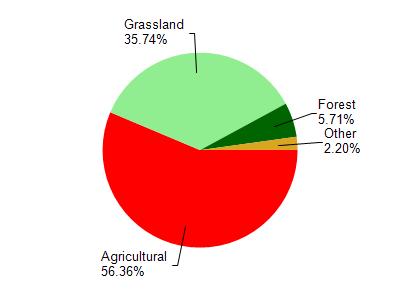Lafayette
No
No
No
Fish and Aquatic Life
Overview
The Wood Branch was a smallmouth bass stream. In 1985 a shocker survey showed bass habitat to be fair to good. Its current existing use is as a warm water forage fishery. The stream is impacted by nonpoint source pollution, cropland erosion, and stream bank pasturing.
Date 2002
Author Aquatic Biologist
Historical Description
Wood Branch,T3N, R3E, Sections 29-8, Surface acres = 11.7, Miles = 5.6, Gradient = 1.8 feet per mile, Total alkalinity = 276 mg/l, Volume of flow = 5.0 cfs.
Wood Branch is a warm water drainage stream which flows easterly into the West Branch of the Pecatonica River. It has three unnamed tributaries with a total perennial base flow of 1.2 cfs. This is equivalent to approximately 25 percent of Wood Branch's base flow. Farming is the major land use throughout the entire basin. Areas immediately adjacent to the stream are usually in firm or meadow pasture. The uplands contain some pasture but are usually devoted to crops. Some woodland exists in the pastures and on the steeper slopes. Erosion of stream banks varies from light to moderate. Severe flooding sometimes occurs after heavy rains. Deep pools and fairly long stretches of deep, quiet water interspersed with riffles provide good habitat for smallmouth bass which are cormnon. Other fishes of importance, although limited, are walleyes, rock bass, channel catfish and bullheads. Silt and gravel are the predominant bottom types with their presence depending upon the swiftness of the water. Game assets include ducks, coots and some muskrats on the lower sections of stream. The uplands contain pheasants, Hungarian partridge, quail, deer, squirrels, and rabbits. Access is limited to two town road crossings since there are no public lands along the stream.
From: Piening, Ronald; Poff, Ronald; Threinen, C.W., 1967. Lake and Stream Classification Project. Surface Water Resources of Lafayette County, Wisconsin Department of Natural Resources, Madison, WI.
Date 1967
Author Surface Water Inventory Of Wisconsin
General Condition
Wood Branch was assessed during the 2018 listing cycle; new biological (fish Index of Biotic Integrity (IBI) scores) sample data were clearly below the 2018 WisCALM listing thresholds for the Fish and Aquatic Life use. This water was meeting this designated use and was not considered impaired.
Date 2017
Author Ashley Beranek
Condition
Wisconsin has over 84,000 miles of streams, 15,000 lakes and milllions of acres of wetlands. Assessing the condition of this vast amount of water is challenging. The state's water monitoring program uses a media-based, cross-program approach to analyze water condition. An updated monitoring strategy (2015-2020) is now available. Compliance with Clean Water Act fishable, swimmable standards are located in the Executive Summary of Water Condition in 2018. See also the 'monitoring and projects' tab.
Reports
Management Goals
Wisconsin's Water Quality Standards provide qualitative and quantitative goals for waters that are protective of Fishable, Swimmable conditions [Learn more]. Waters that do not meet water quality standards are considered impaired and restoration actions are planned and carried out until the water is once again fishable and swimmable
Management goals can include creation or implementation of a Total Maximum Daily Load analysis, a Nine Key Element Plan, or other restoration work, education and outreach and more. If specific recommendations exist for this water, they will be displayed below online.
Monitoring
Monitoring the condition of a river, stream, or lake includes gathering physical, chemical, biological, and habitat data. Comprehensive studies often gather all these parameters in great detail, while lighter assessment events will involve sampling physical, chemical and biological data such as macroinvertebrates. Aquatic macroinvertebrates and fish communities integrate watershed or catchment condition, providing great insight into overall ecosystem health. Chemical and habitat parameters tell researchers more about human induced problems including contaminated runoff, point source dischargers, or habitat issues that foster or limit the potential of aquatic communities to thrive in a given area. Wisconsin's Water Monitoring Strategy was recenty updated.
Grants and Management Projects
| Project Name (Click for Details) | Year Started |
|---|
|
|
Monitoring Projects
| WBIC | Official Waterbody Name | Station ID | Station Name | Earliest Fieldwork Date | Latest Fieldwork Date | View Station | View Data |
|---|
| 926300 | Wood Br | 10014494 | Wood Branch -Upstream Cth O Bridge | | | Map | Data |
| 926300 | Wood Br | 10014495 | Wood Branch - Cth Z Bridge | 10/13/2004 | 10/17/2024 | Map | Data |
|

Watershed Characteristics
Wood Br is located in the Middle Pecatonica River watershed which is 186.42 mi². Land use in the watershed is primarily agricultural (56.30%), grassland (35.70%) and a mix of forest (5.70%) and other uses (2.20%). This watershed has 484.82 stream miles, 27.78 lake acres and 298.28 wetland acres.
Nonpoint Source Characteristics
This watershed is ranked Not Ranked for runoff impacts on streams, Not Ranked for runoff impacts on lakes and High for runoff impacts on groundwater and therefore has an overall rank of High. This value can be used in ranking the watershed or individual waterbodies for grant funding under state and county programs.This water is ranked High Stream for individual Rivers based on runoff problems and the likelihood of success from project implementation.